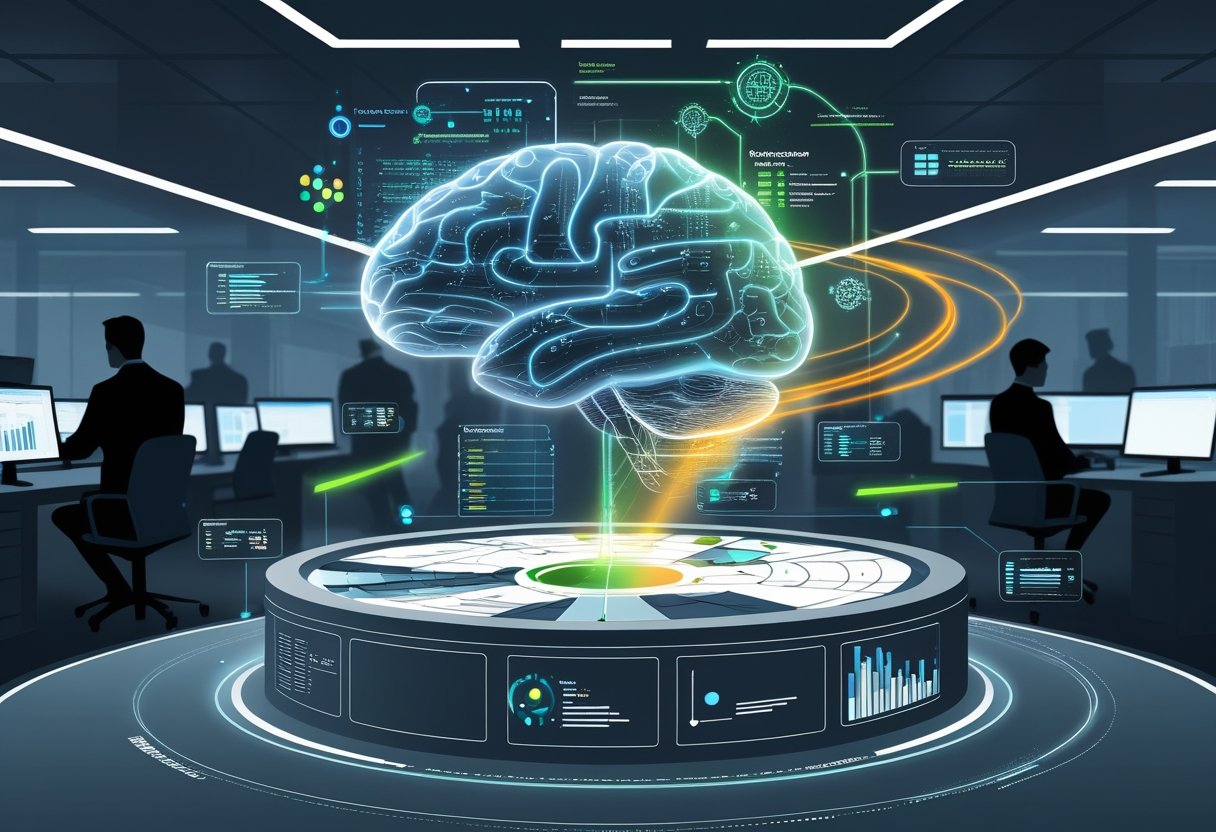AI platforms are quietly collecting and analyzing your business data in ways you might not expect. While you focus on daily operations, these systems gather insights from your communications, documents, and decision patterns.
AI companies are harvesting business intelligence through multiple channels, from employee interactions with AI tools to data shared during platform integrations, often without explicit awareness of the full scope of collection.

Your employees may be secretly using AI tools at work, potentially exposing sensitive business information without your knowledge. When workers input company data into AI platforms for quick answers or assistance, that information becomes part of the platform’s learning process.
This creates a hidden pathway for your competitive intelligence to flow outside your organization. The implications extend beyond simple data collection.
AI platforms analyze patterns in your business operations, strategic communications, and decision-making processes. This intelligence mining affects everything from your competitive positioning to your industry-specific vulnerabilities.
It is crucial to understand how these systems access your data and what steps you can take to protect your business advantage.
How AI Platforms Access and Analyze Business Data

AI platforms use multiple methods to collect your company’s information, from automated data crawling to direct integrations with your existing software systems. These systems then apply machine learning algorithms to extract patterns and insights from both structured databases and unstructured content.
Data Collection Mechanisms in AI Systems
AI systems gather your business data through several key pathways. Direct API connections allow platforms to pull information straight from your databases, CRM systems, and cloud storage.
Many AI data platforms utilize automated data collection to process both structured and unstructured information in real time. This includes emails, documents, spreadsheets, and customer interactions.
Web scraping tools can extract publicly available information about your company. This includes social media posts, press releases, and website content that reveals business strategies.
Cloud-based integrations represent another major collection method. When you use SaaS tools, AI platforms can access your usage patterns, file structures, and workflow data through legitimate API connections.
Data brokers also supply AI platforms with purchased datasets containing industry trends, competitor analysis, and market intelligence that includes your business sector. Some platforms use sensor data and IoT device information if your business operates smart equipment or connected systems.
Role of Generative AI in Data Mining
Generative AI transforms how platforms extract meaning from your business information. These systems can read through thousands of documents, emails, and reports to identify key business insights you might miss.
Large language models process unstructured text data like contracts, meeting notes, and customer feedback. They convert this information into structured datasets for analysis.
Generative AI creates synthetic data models based on your actual business patterns. This helps platforms predict future trends and identify potential risks or opportunities in your operations.
Pattern recognition capabilities allow these systems to spot connections between different data sources. For example, connecting customer complaints with product defects or linking employee communications with project delays.
These AI models can also generate business intelligence reports automatically. They summarize complex data relationships and present findings in formats that look like human-created analysis.
Natural language processing enables generative AI to understand context and nuance in your business communications. It extracts strategic information from casual conversations and informal documents.
AI Integration with Business Intelligence Tools
Modern AI platforms are accelerating business intelligence by embedding directly into your existing software ecosystem. Popular BI tools now include built-in AI features that analyze your data automatically.
Microsoft Power BI, Tableau, and Salesforce all offer AI-powered analytics that process your business data in the background. These integrations happen seamlessly without additional setup from your team.
AI systems connect to your data warehouses through standard protocols like SQL connections and REST APIs. This gives them access to historical business performance, customer behavior, and operational metrics.
Real-time processing capabilities mean AI platforms analyze your data as it enters your systems. Sales transactions, website visits, and customer interactions get processed immediately for insights.
Machine learning models within these tools create predictive analytics based on your specific business patterns. They identify which customers might leave, which products will sell best, or when equipment needs maintenance.
AI analytics platforms also integrate with communication tools like Slack, Microsoft Teams, and email systems. This allows them to gather contextual business information from daily operations.
The Hidden Risks of AI Mining Your Business Intelligence
AI platforms can access and analyze your company’s sensitive data in ways that create serious security and legal risks. These platforms may expose your intellectual property, share information without your knowledge, and contain vulnerabilities that put your business data at risk.
Intellectual Property and Confidentiality Concerns
When you input data into AI platforms, you risk exposing your most valuable business assets. Your trade secrets, strategic plans, and proprietary information become part of the AI’s training data.
Many AI platforms retain copies of your inputs permanently. This means your confidential information could remain in their systems long after you stop using the service.
Critical IP risks include:
- Patent applications and research data
- Customer lists and pricing strategies
- Internal processes and methodologies
- Financial projections and business models
Some platforms explicitly claim rights to use your data for improving their services. This creates a legal gray area where your intellectual property could become part of the AI’s knowledge base.
Your competitors might access similar AI tools that have been trained on data from your industry. This indirect sharing puts your competitive advantages at risk.
Unintended Data Sharing Through Platforms
AI platforms often share your information across their network in ways you don’t expect. Your business data might appear in responses to other users’ queries without your consent.
Security teams need to understand what data is being used to prevent sensitive information leaks. Without proper oversight, employees might unknowingly share confidential details through AI interactions.
Common sharing scenarios:
- Cross-contamination: Your data influences responses to other users
- Model updates: Your inputs help train future versions accessed by competitors
- Third-party integrations: Data flows to partner platforms and services
Many platforms use federated learning systems. These systems share patterns and insights across multiple clients while claiming to protect individual data points.
Your business intelligence becomes part of a larger data pool. Even if your specific information isn’t directly shared, the insights derived from it can benefit other users.
Vulnerabilities in Generative AI Models
Generative AI models contain security flaws that can expose your business data to unauthorized access. These vulnerabilities allow attackers to extract training data or manipulate AI responses.
Prompt injection attacks let malicious users trick AI systems into revealing information they shouldn’t share. Attackers can craft specific queries that bypass security measures and access your data.
AI hallucinations and data privacy breaches can lead to serious business consequences. When AI systems generate false information mixed with your real data, it creates confusion and potential liability issues.
Key vulnerability types:
- Data extraction: Attackers retrieve training data through carefully crafted prompts
- Model poisoning: Malicious inputs corrupt the AI’s responses
- Backdoor attacks: Hidden triggers cause the AI to behave unexpectedly
Cloud-based AI platforms face additional security challenges. Your data travels across multiple servers and networks, creating more opportunities for breaches.
Many generative AI models lack proper access controls. Once your data enters these systems, you lose control over who can access it and how it’s used.
Implications for Strategic Decision-Making and Competitive Advantage
When AI platforms extract your business intelligence, they fundamentally alter how strategic decisions get made. Your proprietary insights become tools that artificial intelligence systems can use against your market position.
How Data Mining Influences Business Strategies
AI platforms analyze patterns from thousands of businesses to identify successful strategies. When your data gets mined, these systems learn from your approaches and share similar insights with competitors.
Your strategic planning process becomes less unique when AI technologies gather and analyze big data for strategic management decisions. The algorithms spot trends in your decision-making that you might not even notice yourself.
Common strategy areas affected by data mining include:
- Market entry timing and geographic expansion
- Pricing models and revenue optimization
- Product development cycles and feature prioritization
- Customer acquisition and retention tactics
AI systems can predict which strategies will work based on data from similar companies. This means your innovative approaches quickly become standard practices across your industry.
The platforms use machine learning to identify which business decisions lead to success. When competitors access these same insights, your strategic advantage shrinks rapidly.
Erosion of Proprietary Competitive Insights
Your competitive edge depends on information that others don’t have. When artificial intelligence platforms mine your business data, they turn your private insights into shared knowledge.
Internal metrics like customer lifetime value calculations and operational efficiency measures become training data for AI models. These models then help other businesses optimize similar processes.
Key proprietary insights at risk:
| Insight Type | How It Gets Compromised |
|---|---|
| Customer behavior patterns | AI identifies buying triggers and preferences |
| Market timing strategies | Algorithms learn optimal launch windows |
| Operational improvements | Systems copy efficiency gains |
| Competitive positioning | Platforms analyze differentiation approaches |
Your unique understanding of market gaps gets absorbed into AI-enabled business models for competitive advantage that benefit multiple companies. The intelligence you developed through years of experience becomes available to newcomers.
Artificial intelligence systems excel at finding patterns in strategic decisions across industries. When your confidential business intelligence feeds these systems, you lose the information advantage that separates successful companies from their competitors.
Industry-Specific Perspectives: Mining Industry and Beyond
The mining sector demonstrates how AI platforms extract valuable operational data while companies focus on mineral extraction. Your industry faces unique challenges where AI is transforming mining operations while simultaneously collecting your business intelligence.
AI Applications in the Mining Industry
Your mining operations now rely on AI systems that monitor every aspect of your business. These platforms track equipment performance, worker productivity, and operational costs in real-time.
AI is increasingly being utilized in mining to improve three key areas:
- Safety monitoring: AI cameras and sensors record worker movements and safety protocols
- Equipment optimization: Machine learning algorithms analyze your equipment data patterns
- Predictive maintenance: Systems collect data about your maintenance schedules and costs
Your AI platforms gather detailed information about your mining processes. They learn your production schedules, identify your most profitable operations, and map your resource allocation strategies.
The data collection happens automatically through connected devices. Your drilling equipment, conveyor systems, and processing facilities feed information directly to AI platforms.
Discovery of Mineral Deposits Using AI
Your exploration activities generate massive amounts of geological data that AI platforms analyze. These systems process your survey results, drilling samples, and geological maps to identify potential mineral deposits.
AI platforms collect your proprietary exploration data including:
| Data Type | Business Intelligence Extracted |
|---|---|
| Geological surveys | Location of valuable deposits |
| Drilling results | Ore quality and quantity estimates |
| Satellite imagery | Land acquisition strategies |
| Historical data | Success rates and investment patterns |
Your mineral exploration using AI reveals competitive advantages to platform providers. They gain insights into your most promising sites and investment priorities.
The AI systems learn which geological formations you target. They understand your exploration budgets and decision-making processes for new projects.
Impact on Supply Chain Security and Operations
Your mining supply chain data flows through multiple AI platforms that track shipments, pricing, and delivery schedules. These systems monitor your relationships with suppliers, customers, and logistics partners.
AI applications in mining operations create detailed maps of your supply network. The platforms know your shipping routes, storage locations, and inventory levels.
Your operational data reveals sensitive business information:
- Contract terms with major buyers
- Pricing strategies for different markets
- Production capacity and expansion plans
- Cost structures across different operations
The AI systems track your responses to market changes. They learn how you adjust production when commodity prices fluctuate and identify your most profitable customer relationships.
Your supply chain AI platforms share this intelligence across their networks. Competitors using the same platforms potentially access insights about your operational strategies and market positioning.
Protecting Your Business Intelligence from AI Platforms
Companies must implement strong data security practices and understand legal requirements when using artificial intelligence tools. These steps help prevent unauthorized access to sensitive business information.
Best Practices for Data Security
Start by creating a data classification system. Label information as public, internal, or confidential before sharing it with any AI platform.
Never upload customer data, financial records, or trade secrets to public AI tools. These platforms often store and analyze your inputs for training purposes.
Use private AI solutions instead of public ones for sensitive work. Private AI keeps your data safe by running on your own servers or dedicated cloud environments.
Set up access controls for your team. Only allow specific employees to use AI tools for business tasks.
Create clear rules about what information can and cannot be shared.
Key security measures include:
- Employee training on AI data risks
- Regular audits of AI tool usage
- Encrypted connections for all AI interactions
- Data retention policies with AI vendors
- Backup systems that don’t rely on AI platforms
Monitor which AI platforms your employees use. Many workers upload business documents without knowing the security risks of data over-sharing.
Legal and Regulatory Considerations
Check your industry’s data protection rules before using AI tools. Healthcare, finance, and government sectors have strict requirements about where data can be stored.
Review AI platform terms of service carefully. Many services claim rights to use your data for improving their artificial intelligence models.
Important legal steps:
- Update privacy policies to mention AI usage
- Get customer consent before processing their data with AI
- Document where business data flows through AI systems
- Create contracts with AI vendors about data handling
Some countries require companies to keep citizen data within their borders. Cloud-based AI platforms may store information in different countries without your knowledge.
Work with your legal team to understand liability issues. If an AI platform exposes your customer data, your company may still face penalties and lawsuits.
Consider regulatory compliance challenges that come with AI adoption. New laws about artificial intelligence are being created in many regions.
Frequently Asked Questions
Business leaders face complex challenges when AI platforms access their internal data for mining operations. These concerns span from immediate security risks to long-term competitive disadvantages and regulatory compliance issues.
What are the implications of AI platforms accessing proprietary business data?
AI platforms can expose your company’s competitive advantages when they access proprietary information. Your trade secrets, customer lists, and strategic plans become vulnerable to unauthorized use or disclosure.
Trade secret protection faces new challenges as AI technologies create unprecedented risks for confidential business information.
Your business intelligence may be used to train AI models that competitors can access. This means your hard-earned insights could benefit rival companies without your knowledge or consent.
Public AI tools often operate on shared infrastructure, meaning your sensitive data could reside on the same servers as competitor information.
If these systems are compromised, your proprietary data becomes accessible to other platform users.
How can businesses safeguard against unauthorized data mining by AI tools?
You can implement rate limiting on your servers to prevent excessive page requests from AI crawlers. This technique blocks bots that attempt to download hundreds of pages per minute, which humans rarely do.
The robots.txt file serves as your first line of defense against unwanted AI scraping. You can use this file to deny access to specific AI bots while still allowing legitimate search engines to index your content.
Anti-scraping services offer more advanced protection through behavioral analysis and bot detection. Companies like Cloudflare, Akamai, and DataDome use machine learning to identify non-human access patterns.
You should consider implementing JavaScript challenges and honeypot traps on your website. These hidden elements capture bots that attempt to scrape all available content, triggering automatic server blocks.
In what ways might AI-enhanced analytics unintentionally expose sensitive company information?
Your business data becomes fragmented across different AI platforms, creating multiple exposure points.
AI analytics tools may inadvertently reveal patterns in your data that expose confidential strategies. Customer behavior analysis, sales forecasting, and market predictions can leak sensitive business intelligence.
Cross-platform data sharing between AI tools creates additional vulnerabilities. Your information processed by one AI service may be accessible to other connected platforms without your explicit consent.
Query logs and search patterns in AI systems can reveal your business priorities and strategic focus areas. Competitors monitoring these patterns gain insights into your company’s direction and planning.
What measures are in place to ensure AI tools comply with data privacy regulations?
Most AI platforms claim to follow GDPR, CCPA, and other privacy regulations, but enforcement remains inconsistent. You must verify that any AI tool you use provides clear documentation of their compliance measures.
Data residency requirements vary by region, and many AI platforms cannot guarantee where your information will be processed or stored. This creates compliance challenges for businesses operating in multiple jurisdictions.
You should implement data classification systems before using AI tools. This allows you to identify which information can be safely processed and which requires additional protection measures.
Regular audits of AI tool permissions and data access logs help ensure ongoing compliance. You need to monitor how your data is being used and shared across different AI platforms.
How do AI platforms contribute to competitive intelligence gathering practices?
AI companies actively scrape web content to train their models, often without explicit permission from content creators. OpenAI’s ratio of pages scraped to visitors redirected is now 1,500 to 1, meaning they extract massive value while providing minimal traffic back.
Your competitor analysis, market research, and strategic documents become training data for AI models. This information can then be used to generate insights that benefit competing organizations.
AI platforms aggregate industry data across multiple companies, creating comprehensive competitive intelligence databases. Your individual contributions become part of larger datasets that reveal market trends and opportunities.
Pattern recognition in AI systems can identify relationships between different companies and industries. This capability allows competitors to understand market dynamics and strategic positioning more effectively.
What are the ethical considerations surrounding AI and the use of business intelligence?
AI companies profit from business data without compensating the original creators or owners. This practice raises questions about fair value exchange and intellectual property rights in the digital economy.
Your employees’ work and analysis become training data for AI systems that may eventually replace human workers. This creates ethical dilemmas about using human intelligence to build competing automated systems.
Transparency in AI data usage remains limited. It is difficult for businesses to understand how their information is being utilized.
Most AI platforms provide vague explanations about data processing and sharing practices. The concentration of business intelligence in a few major AI platforms creates power imbalances in the market.
Smaller companies may find themselves at a disadvantage when their data primarily benefits larger competitors through AI analysis.


